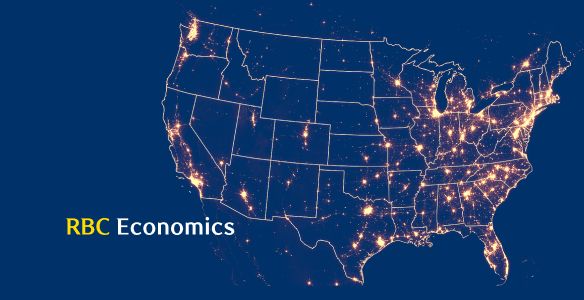Canada’s largely steady growth in 2024 compared to 2023 masked notable regional shifts. The first set of provincial GDP estimates (on an industry basis) confirmed our earlier forecast that Prairie provinces would emerge as Canada’s economic growth leaders in 2024. That marked a shift from 2023 when Ontario contributed most to national growth. Canada’s eastern provinces followed suit by recording above average growth in real GDP while Ontario and B.C. trailed most provinces.
PRAIRIES
Prairie provinces collectively accounted for over one-third of national growth last year. Continued in-migration and solid commodity markets offered notable supports for the region, with the exception of Manitoba which suffered from a setback in the utilities sector.
Alberta contributed more than a quarter to national growth—nearly matching the contribution of Canada’s largest provincial economy, Ontario. The province benefited from a 3.7% increase in oil and gas extraction which significantly boosted its goods-producing sector. Strong population growth also supported growth among services industries.
Saskatchewan benefited from increased output in metal ore mining (+36%) and potash mining (+8.3%), though manufacturing declined 4.6%. Construction was a major growth driver in the province (+13%), bolstered by ongoing work on the Jansen Potash mine.
Manitoba saw slower growth in 2023, with the utilities sector acting as a significant drag (-5.1%) due to unusually low water reservoir levels from 2023 droughts.
EASTERN CANADA
Growth accelerated in eastern Canada, lead by services sector gains, despite the sharp slowdown in population growth. Public sector expansion, resource sector rebounds, and construction activity were common growth drivers throughout eastern Canada.
Quebec services growth offset a 0.8% decline in goods production, lead by a 2.6% drop in manufacturing. Educational services rebounded after a strike at elementary and secondary schools in late 2023 came to an end, supporting an overall expansion of real GDP (1.3%) in 2024—which doubled its pace compared to 2023.
Nova Scotia benefited from robust growth among services sectors. Headwinds from mining sector declines following the closure of Touquoy Gold Mine prevented a more robust expansion.
Newfoundland and Labrador rebounded in 2024 after two consecutive years of decline. The 2.4% real GDP expansion offset an equally as large decline in 2023. The turnaround was largely supported by a 4.6% recovery in oil and gas extraction and a 34% surge in metal mining.
New Brunswick saw services growth offset goods production weakness. Public administration and healthcare grew at a faster pace than in 2023 after healthcare shortages and labour disputes among public sector workers had been addressed. The utilities sector was the largest detractor from growth (-18.1%) due to lower electricity generation and reduced out-of-province sales.
Prince Edward Island’s real GDP expansion topped the charts at 3.6% in 2024, driven by real estate and rental/leasing (+5%), and healthcare and social assistance (+4.4%). Construction also surged with residential construction up 14% as housing starts reached near-record levels.
ONTARIO & B.C.
Growth moderated in Ontario and B.C.—Canada’s most interest-rate sensitive provincial economies. The lagged impact of past interest rate hikes by the Bank of Canada continued to squeeze household budgets and business investment which pinched the construction and real estate industries.
Ontario’s overall economic performance was dampened by weakness in goods-production (-2.3%) and manufacturing (-4.7%) industries compared to 2024. Residential construction also declined for a third consecutive year in the province, pulling real GDP growth down to 1.2% in 2024 from 1.8% in 2023.
British Columbia’s growth engine sputtered in 2024, with real GDP expansion halving to 1.2% from 2.4% in 2023. Construction activity was a weak spot (-5.7%) with residential construction falling 8.8%. The province’s goods-producing sectors dragged heavily on performance too, with manufacturing output plunging 6.2% and overall goods production falling 2.9%.
Rachel Battaglia is an economist at RBC. She is a member of the Macro and Regional Analysis Group, providing analysis for the provincial macroeconomic outlook and budget commentaries.
This article is intended as general information only and is not to be relied upon as constituting legal, financial or other professional advice. The reader is solely liable for any use of the information contained in this document and Royal Bank of Canada (“RBC”) nor any of its affiliates nor any of their respective directors, officers, employees or agents shall be held responsible for any direct or indirect damages arising from the use of this document by the reader. A professional advisor should be consulted regarding your specific situation. Information presented is believed to be factual and up-to-date but we do not guarantee its accuracy and it should not be regarded as a complete analysis of the subjects discussed. All expressions of opinion reflect the judgment of the authors as of the date of publication and are subject to change. No endorsement of any third parties or their advice, opinions, information, products or services is expressly given or implied by Royal Bank of Canada or any of its affiliates.
This document may contain forward-looking statements within the meaning of certain securities laws, which are subject to RBC’s caution regarding forward-looking statements. ESG (including climate) metrics, data and other information contained on this website are or may be based on assumptions, estimates and judgements. For cautionary statements relating to the information on this website, refer to the “Caution regarding forward-looking statements” and the “Important notice regarding this document” sections in our latest climate report or sustainability report, available at: https://www.rbc.com/community-social-impact/reporting-performance/index.html. Except as required by law, none of RBC nor any of its affiliates undertake to update any information in this document.


